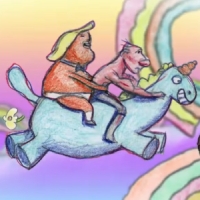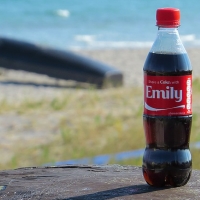- About Us
- Columns
- Letters
- Cartoons
- The Udder Limits
- Archives
- Ezy Reading Archive
- 2024 Cud Archives
- 2023 Cud Archives
- 2022 Cud Archives
- 2021 Cud Archives
- 2020 Cud Archives
- 2015-2019
- 2010-2014
- 2004-2009
 |
Shooting the Bull |
Shooting the Bull is about me writing shorter, more bite-sized essays. But it’s a new year, so that means it’s All Things Lit month at The Cud. So here are the usual short essays… but more of them.
How the Left Acts Like the Right
The ideals of the far left and far right differ, but they both twist reality to suit their platforms. When you refuse to see any common sense through your beliefs, you don’t help your cause that much.
The New York Times got in viral trouble in July 2018 when it ran a cartoon depicting Donald Trump and Vladimir Putin being lovers. Immediately, the far left erupted with fury. The Times is homophobic! They depict homosexuality as shameful or laughable! The cartoon will cause others to bully LGBT youth! Homosexuality isn’t something you can do cartoons about!
Yes it is—everything is. But the cartoon wasn’t AT ALL homophobic. It clearly depicted Trump and Putin being lovers because Trump made a nonstop public embarrassment of himself fawning over Vlad, making nonsensical political concessions to Vlad, putting Vlad before the American people, etc. The joke was that Trump must be in love with Putin.
But those on the far left pretended—or perhaps convinced themselves—that it was gay bashing. The cartoon is something it isn’t, and the Times is responsible for whatever fallout we imagine because of it to get public attention!
This cartoon needed no explanation. The far left twisted reality, manufactured controversy, or were just being dumb as rocks. Sound like any other group we’re painfully familiar with? Yep. Sounds like the far right. Your sociopolitical platform is far better than the rights, lefties; don’t turn yourselves into cartoon characters that nobody can take seriously.
If you haven’t seen the video, which is not only funny but has constant audio of Trump saying Trump things, watch it:
https://www.youtube.com/watch?v=1KC7lctZYsA
Who Gets to Live?
Jimmy Kimmel got in trouble on his show in September 2021.
“Dr. Fauci said if hospitals get any more crowded, they're going to have to make some very tough choices about who gets an ICU bed,” Kimmel said. “That choice doesn't seem so tough to me. Vaccinated person having a heart attack? Yes, come right on in. We'll take care of you. Unvaccinated guy who gobbled horse goo? Rest in peace, wheezy.”
The joke referred to anti-vaxxers who take ivermectin, an antiparasitic used primarily in animals. These idiots believe it will magically cure them, but any possible antiviral effect involves levels of ivermectin toxic to humans.
The far right lost its collective mind, but Kimmel wasn’t wrong. Vaccinations save the lives of the vaccinated and protect others around them. Those who refuse them because of silly conspiracy theories certainly should be sent to the bottom of the triage list—behind everyone smart enough to understand how a vaccine works—and be disallowed further risking others IN THE HOSPITAL. It’s simple math and basic logic, folks.
ICU beds nationally are filling up with unvaccinated COVID patients, denying beds to people with other ailments. Meanwhile, there are online anti-vax groups urging people to NOT go into ICUs, and to treat with ivermectin and other unproven silliness. More power to them. It’ll free up beds for those who deserve medical treatment. If these anti-vaxxers insist on conspiracy theories instead of common sense, then let them remove themselves from the gene pool—and the voter rolls.
Listicles Suck
Listicles are the logical progression from giving everyone Internet access. They represent lazy writing, but apparently you can make a living writing them if your writing skills are at a sixth-grade level. On that note, here are two listicles because I’m feeling punchy and want to offend just about everyone. Here are a pair of top-10 lists that, point by point, are very similar yet very different.
10 Reasons the Far Right Hates Me
1. I think everyone should be equal.
2. I’m an atheist who thinks religion should never be the basis for denying someone else’s rights.
3. I don’t think that people who served in the military are superheroes by default, nor do I thank them for their service. They got paychecks.
4. Your lack of understanding or acceptance of other races, genders, gender identities, and sexual preferences doesn’t matter. They exist. Get over it.
5. Social-services programs are needed in a civilized society.
6. The Senate filibuster should go away regardless of whether you’re nervous about it being gone when your preferred party isn’t the majority.
7. Republicans are unethical, immoral, and evil.
8. Black people are people. It’s time to accept that.
9. I believe in communism—just not how it’s been implemented so far.
10. You believe in fake news, conspiracy theories, and other things, but an intelligent grade-schooler can see that they aren’t true.
10 Reasons the Far Left Hates Me
1. I think if straight people can’t play gay people and cis people can’t play transgender people without you losing your mind, then Black people shouldn’t play Anne Boleyn and Hispanics shouldn’t play Alexander Hamilton. Double standards suck no matter your reasoning.
2. I’m an atheist who doesn’t respect any religious beliefs; I respect your rig ht to believe in them, but don’t expect me to take your absurd fantasies seriously.
ht to believe in them, but don’t expect me to take your absurd fantasies seriously.
3. I believe in peace through superior firepower and we should destroy aggressors from afar without endangering Americans.
4. Every TV episode and movie produced doesn’t need to have every minority and every gender identity featured just because you feel a responsibility to check off a list.
5. We enable too many welfare recipients who shouldn’t have to be on welfare and who drag down that necessary system.
6. The Senate filibuster should go away regardless of whether you’re nervous about it being gone when your preferred party isn’t the majority.
7. Democrats are inept, directionless, and incompetent.
8. Black, colored, African American—every time they decide that what I say is no longer acceptable, somehow I’m a bad guy for using it. So if “colored” is a horrible term, why is the NAACP still using “colored people”?
9. I believe in socialism—just not how it’s been implemented so far.
10. You believe in pipe dreams, hopes, and other things, but an intelligent high-schooler can see that you haven’t the slightest idea how to make any of them reality.
Where Welfare Fails
Welfare is necessary and good, but it often fails. In my life, I’ve been on food stamps, received General Assistance to pay my rent, and lived in a homeless shelter; I’ve seen more cases of welfare abuse than I can count. No, it’s not all “welfare queens” as Reagan famously said, but there are massive failures in the system. Here’s a case study.
Someone in my family—“Emily”—was on welfare a few years ago. Emily had a child and allegedly intentionally got pregnant with her second to get a welfare-check increase. While raising her two children, Emily got full-time job with a national chain. Sounds good, right? Onward and upward? Working to earn her living and get off the public dole? Sure, let’s say that.
Emily was involved in various welfare programs, and clearly they didn’t all get together. Emily’s full-time job didn’t pay great, but it paid. But Emily couldn’t work 40 hours a week with two young children, so a social-service agency paid for her child care so she could work. One has to question the value of paying for child care so Emily could earn minimum wage.
Meanwhile, she couldn’t afford gas to drive to and from her job, so another social-service program reimbursed her for her mileage, which helped pay for her gas. This didn’t pay for upkeep on the car, though, so when it broke down, another program paid to fix her car. Making sense yet?
 Now, she still got a monthly welfare check, and she also got food stamps. Emily always had money to buy expensive pets, fancy electronic toys, cigarettes, and all the junk food and soda she could handle—well, of course; social-service programs paid her child care, mileage, and vehicle repairs, along with food and monthly check, so she had lots of extra cash to have fun with. How much money did taxpayers spend so that she could work for minimum wage, anyway?
Now, she still got a monthly welfare check, and she also got food stamps. Emily always had money to buy expensive pets, fancy electronic toys, cigarettes, and all the junk food and soda she could handle—well, of course; social-service programs paid her child care, mileage, and vehicle repairs, along with food and monthly check, so she had lots of extra cash to have fun with. How much money did taxpayers spend so that she could work for minimum wage, anyway?
It gets better. Despite all of these great programs supporting her, Emily decided she didn’t like working… so she quit her job. Now she was back on welfare, so she got more food stamps. Had she started making too much money and it threatened her welfare check? Probably.
Is ANY of that a sensible use of welfare money? Emily was making about $7.50 an hour at her job, so after taxes she was pulling down maybe $1,000 a month. How much do you think they spent to keep her in the workforce? Between child care, mileage reimbursements, and vehicle repairs, I’m 100% certain they were paying out more money than she was taking in.
Welfare is a safety net, not a lifestyle, but I can tell you from firsthand experience that there are many people who use it as the latter—and weaken the system, taking funds from others who need them. When people in Maine are freezing in the winter and cannot afford heating oil and are told the funds have run out, this is part of the reason why.
It’s time to fix welfare. But we won’t. The right wants to end it entirely and the left wants to expand it without any common sense. What’s the fix for that?
Fixing Food Stamps
Food stamps, these days called SNAP for Supplemental Nutrition Assistance Program, comes on a rechargeable debit card. Any grocery items are fair game, including pizzas and sub sandwiches so long as they aren’t cooked beforehand. When I got food stamps (in the stamp form decades ago) I had to make a few dollars stretch. I shopped wisely, getting inexpensive store brands instead of the alternative.
But you don’t have to. No, you can use your SNAP card to buy soft drinks, candy, and high-priced garbage. And if you’re too good for store brands, you can buy the premium brands. And it’s all legal, and neither Republicans nor Democrats will do anything to fix it. The state of Maine tried to pass legislation to prevent using SNAP to buy junk but it died—in a Democratic legislature.
These days, everything is database-driven. When a cashier scans a barcode, software looks up the items in a database and brings up the price. The database stores lots of information, such as if there is a discount for a store membership card, if there’s an extended warranty available on something, how much the item weighs for when you’re doing self-checkout, the costs per ounce or pounds or whatnot, and so forth. It would be as easy as adding a database field for whether an item is SNAP-allowed, or even how much SNAP will pay. Want spaghetti sauce? Perhaps SNAP says it will cover $1.50 for X ounces. If you want Prego and it’s $2.00, you’re coming up with the other 50 cents. And junk food? It’s pretty easy to say that we should get rid of all that. Yes, I know, think of the children, but I grew up with limited junk food and I survived.
When we can’t fix idiot-proof things like disallowing candy bars and soda with welfare funds, or controlling costs by limiting how much people can spend on a certain type of item, how will we ever fix welfare in the United States?
The Deterioration of Star Trek
Star Trek used to be awesome. I grew up on it. The high-class morality plays disguised as sci-fi were fantastic. The scripts were smart, the actors were great, and the themes were as adult and real-world as the setting was hopeful of the future. Even Star Trek: The Animated Series was stellar, far above usual Saturday-morning fare. And in 1987, lightning struck again when Star Trek: The Next Generation debuted.
Then Gene Roddenberry died. Many spoke of how he was a pain in the neck behind the scenes, and that might well be, but since his death Star Trek has never been the same.
First came Star Trek: Deep Space Nine. Not horrible, but not great. They got smart and added a starship so the crew could leave the space station and have adventures elsewhere, but it was always weak in comparison to TOS and TNG—like a reflection in a warped mirror, perhaps.
Then came Star Trek: Voyager, with a great premise but no balance. When they poured Jeri Ryan into that bodysuit to show off her assets, and no one even bothered to explain to her that the Borg collective had always pronounced “futile” as “FYOO-tile” and not “FYOO-til,” Star Trek’s warped mirror was cracking.
Up next: Star Trek: Enterprise, a prequel, which ignored the whole point of looking ahead. Okay, you get ONE prequel. And they didn’t do it well. It could be fun, and the actors were good, but I think that while actor Jolene Blalock seemed to understand the Star Trek mythos, nobody else seemed to. From the pop song and American-centric video montage during the opening credits to Connor Trinneer’s tantrum about the show’s finale being interwoven with ST:TNG, it was clear that any cohesive understanding of Star Trek was gone. The mirror was a spiderweb of a thousand cracks.
 Then J.J. Abrams just had no freaking clue what he’d been given and his three movies showed it. I’ve written about them before, so I won’t belabor my point, but instead of rebooting TOS and making some new timeline just to capitalize on Kirk and Spock, they could have created a new ship and a crew and… well, Hollywood isn’t much for creating, right? Reboot, redo, remake; that’s all they know. Glass was everywhere!
Then J.J. Abrams just had no freaking clue what he’d been given and his three movies showed it. I’ve written about them before, so I won’t belabor my point, but instead of rebooting TOS and making some new timeline just to capitalize on Kirk and Spock, they could have created a new ship and a crew and… well, Hollywood isn’t much for creating, right? Reboot, redo, remake; that’s all they know. Glass was everywhere!
Along comes Star Trek: Discovery, another prequel… well, as I said, you get ONE. And any reservations I had about ENT pale in comparison to this disaster. But at this point someone had swept up the glass in this incredibly strained mirror metaphor, so it couldn’t get any worse, right?
Oh, but it could. Star Trek: Picard sounded positive, but they managed to ruin that, too. And Patrick Stewart, of all people, has been complicit in this tangled mess. I suffered to make it through the first season’s ten episodes. Yes, they put all the glass pieces back together to try to revisit a wonderful era, but all they had done was give us a twisted image of what had once been.
Watching the deterioration of Star Trek is like watching the deterioration of the mind of a loved one with dementia. It’s painful.
Fortunately, Seth MacFarlane’s The Orville remains. Seth is the only one in the business who seems to understand what Star Trek was all about, because he’s doing it on his show, albeit with a lot more humor. The Orville is better Star Trek than Star Trek, and that should tell you something about the people in charge of Star Trek.
I’d beg Disney to buy Paramount and take over Star Trek, but that’s the same outfit that brought in J.J. Abrams to do to Star Wars what he’d already done to Star Trek, so I think it’s just time to accept that Star Trek as we used to know and love it is long dead.
To those who have the same feelings: Live long and prosper. Star Trek will, but that won’t make it good.
David M. Fitzpatrick is a fiction writer in Maine, USA. His many short stories have appeared in print magazines and anthologies around the world. He writes for a newspaper, writes fiction, edits anthologies, and teaches creative writing. Visit him at www.fitz42.net/writer to learn more.
